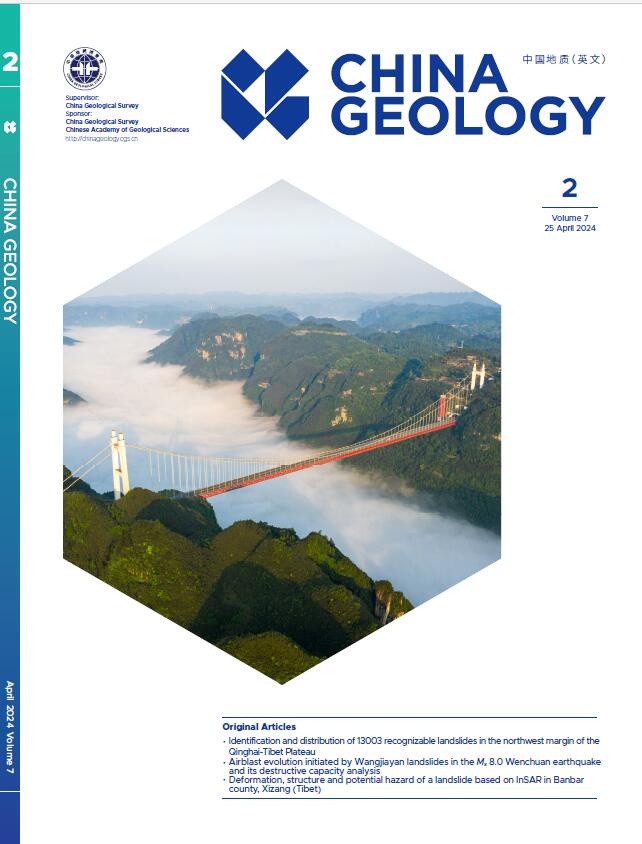

| Citation: Zhang Yong-shuang. 2024. Enhancing landslide hazards survey and management to reduce the loss of human lives and properties. China Geology, 7(2), 169‒170. doi: 10.31035/cg2024080. |
Landslides are pervasive geohazards that pose a serious threat to human lives, property, and crucial engineering constructions. Annually, landslides lead to tens of thousands of fatalities (see the paper of “List of typical catastrophic landslides from March 2004 to February 2024” in this issue, doi: 10.31035/cg2024079) and cause economic damages amounting to billions of dollars around the world, as well as disrupting crucial infrastructures such as railways, highways, hydropower stations, etc. Due to the intensification of climate change, seismic activity, and human engineering activities, the severity and frequency of landslide disasters have seen a marked increase. According to the data from the Ministry of Emergency Management of the People’s Republic of China, the Chinese mainland experienced 16029 landslides from 2019 to 2023, characterized by broad distribution, high frequency, and severe damage. Considering the destructive impact of landslides on regional economic development, landslides have become the focal point in the government’s disaster prevention and mitigation efforts.
Landslides are controlled by the coupling of endogenic and exogenic geological processes and are the result of the evolution of slopes. The slope features, rock mass structure, and stratigraphic lithology are considered inherent conditions, while dynamic processes (earthquake and human-induced) and water (precipitation and river erosion) are considered triggering conditions. In recent years, a significant number of studies have been conducted on landslide formation mechanisms, deformation behaviors, slope stability analysis, monitoring techniques, and early warning methods. However, due to the complexity of the geological process, the concealed nature of landslides, and the state transitions during the emplacement, the processes and mechanisms of many landslides are still obscure, and further research is needed for effective landslide prediction and prevention. Some challenging issues faced by researchers globally include the early identification of large landslides, landslide formation mechanisms of high-altitude and long-runout landslides, monitoring and early warning techniques of landslides, and landslide risk prevention measures.
As a pivotal subfield of geosciences, landslide research is related to a multitude of disciplines, including geology, meteorology, environmental science, and engineering technology. In recent years, the rapid progression in science and technology, particularly the integration of remote sensing, Geographic Information Systems (GIS), artificial intelligence (AI), and big data analytics, has led to significant advancements in the field of landslide formation mechanisms, early identification, monitoring methodologies and risk assessment strategies. For example, the integrated aerospace-aviation-surface-underground four-in-one landslide hazard identification system has been proposed; the distinctive formation mechanisms of landslides influenced by geotechnical properties specific to loess, red beds, and karst areas have been elucidated; the millimeter scale landslide deformation early detection and monitoring techniques have been established; the evolution process of high-altitude long-runout landslide chain have been revealed; the multi-conditions risk evaluation model based on physical processes have been developed, the landslide early warning model based on machine learning and artificial intelligence have been developed. Based on the above contributions, a Chinese disaster prevention pattern, characterized by “Human + technological defense”, has been constructed and applied, effectively reducing casualties and property losses caused by landslide disasters and achieving significant disaster prevention effects.
To facilitate the development and dissemination of landslide monitoring and prevention technologies, the editorial team of China Geology initiated and organized a special issue on Landslide Monitoring, Early Warning, and Risk Assessment. It brings together 13 studies in key areas such as the characteristics and evolution mechanisms of giant landslide hazard chains, landslide monitoring and early warning technologies, and landslide susceptibility models.
Four of the papers investigate landslide characteristics and formation mechanisms, including the spatial distribution and determining factors of large landslides on the Northwestern Tibetan Plateau, the hydraulic properties and effects of loess in different landslide-prone areas on the Loess Plateau, the deformation characteristics and mechanisms of Banda landslides in Tibet, and the structure characteristics and geophysical markers of the slip zone in Deda landslide.
Five papers are centered on modeling and forecasting the deployment of landslides. They cover the kinematic evolution and airblast propagation of the Wangjiayan landslide in the Wenchuan earthquake area, examine the movement process of the Yigong landslide under the friction weakening effects, detail the creep buckling failure process of the Shanyang landslide controlled by influenced by precipitous layered geological formations, present the runout prediction of Jiashanying landslide based on the multi-source data collaboration analysis, and assess the risk of the Xinqiaogou debris flow and the disaster reduction effects of their prevention engineering project.
Four papers address the advanced methodologies for landslide detection and monitoring. They review the progress and challenges of deep learning for landslide mapping, introduce the prediction of short-term landslide displacement utilizing transfer learning methods, explore the high-accuracy landslide boundary automatic identification technology based on deep learning models, and assess the potential of leveraging the AutoGluon framework for calculating landslide susceptibility.
During the organization, solicitation, and selection process of this special issue, we received extensive help from the editorial team of China Geology, as well as our collaborators from the China University of Geosciences (Beijing), Southwest Jiaotong University, and the Institute of Geomechanics, Chinese Academy of Geological Sciences, among others. Here, we express our sincere thanks to all involved. It is our hope that the publication of this special issue will promote communication and collaboration among the academic community, government, and geotechnical engineers. Through our collective endeavor, we aim to advance the level of landslide disaster monitoring, early warning systems, and risk assessment, thereby providing substantial scientific support for the prevention of landslide disasters on a global scale.
